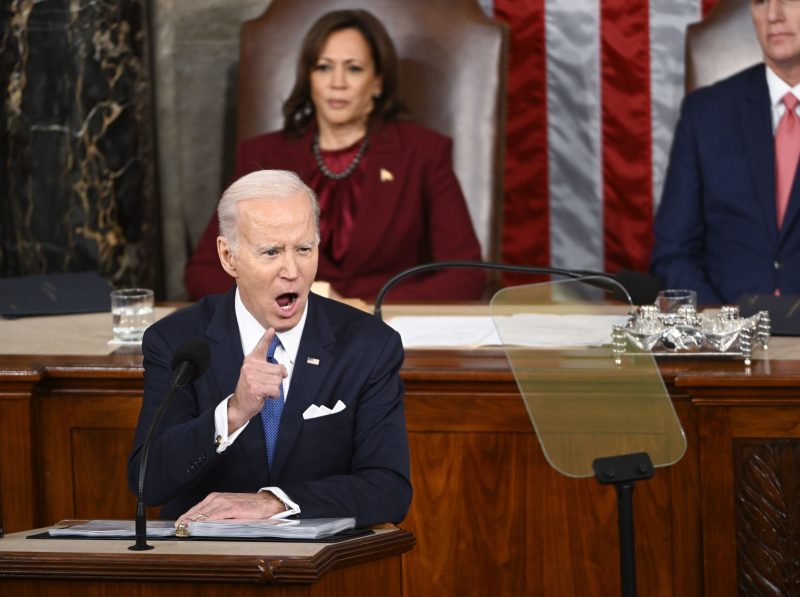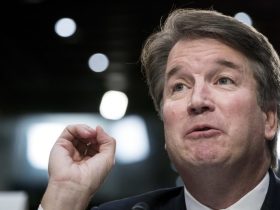“Covid left its scars, like the spike in violent crime in 2020 — the first year of the pandemic.”
— President Biden, remarks in the State of the Union address, Feb. 7
We quickly fact-checked various claims in the president’s address to Congress last week, but there’s usually something that requires a bit more digging. That’s the case with this line, which appeared to make a direct connection between an increase in violent crime and the coronavirus pandemic.
Crime data often takes a long time to collect — and trends that cause crime rates to fluctuate are not readily apparent. Even three years after much of the world shut down their economies to halt the spread of the virus, analysts still are examining what might have sparked an upswing in violent crime. The culprits could include economic turmoil from the pandemic, social justice unrest after the killing of George Floyd and a sharp increase in gun purchases — or a combination of all three.
Trend lines also have to be kept in perspective. Violent crime rates in 2020 were similar to those in 2016 — and still far below the rates between 1985 and 2009, according to FBI statistics. Still, homicides rose by 29 percent in 2020, the largest one-year increase in at least 50 years.
By itself, Biden’s State of the Union line appears to suggest that the pandemic was responsible for the violence. But White House officials said the remarks did not say covid was the only factor in the increase in crime; they said the remarks only suggested it was a factor, which is a view shared by multiple experts. They noted that in the preceding section, Biden had been discussing the various wide-ranging effects covid had on lives, and his next sentence segued into a discussion of criminal justice, with Biden noting that “public safety depends on public trust, as all of us know. But too often, that trust is violated.” He then recognized the parents of Tyre Nichols, who was killed by Memphis police after a traffic stop.
So what does the latest research show?
The most immediate result of the stay-at-home restrictions is that violent crime rates fell or remained stable across the globe — and then in most cases returned more or less to previous rates after reopening. This is shown in study after study in various countries and different cities.
“When restrictive measures were in place, in some countries the decrease in the homicide trend in March/April 2020 was more than 25 percent larger than the average recorded in those months over the period 2015—2019,” said a 2020 study issued by the U.N. Office on Drugs and Crime. “However, the pre-lockdown trend re-emerged once measures were relaxed.” Meanwhile, “the decrease in reported robbery was more than 50 percent in the majority of countries” during lockdown restrictions but the report said continuing economic turmoil could lead to a spike.
But the same pattern did not occur in the United States. Homicides rose dramatically in 2020, as did some other violent crimes.
In the United States, the 2020 lockdown restrictions began in mid-March and began to ease in May. On May 25, George Floyd, a Black man, was killed by a White Minneapolis police officer, prompting demonstrations across the United States, some of which involved violence and property damage by protesters. Then, that summer, homicides appeared to spike.
The impact of those social justice demonstrations was unique to the United States — a combination of less policing and loss of confidence in police in marginalized communities — leading many to conclude that they were related to the rise in violent crime. At the same time, the conditions created by the pandemic may have exacerbated the impact.
The White House initially provided three sources to back up the president’s statement — but all said the president’s pandemic-focused phrasing was incomplete.
Richard Rosenfeld, co-author of a January study for the Council on Criminal Justice cited by the White House, said in an email that Biden “went too far” in linking the rise in violent crime to the pandemic.
“Violent crime did go up in 2020 at the height of the pandemic, but the violent crime rate in 2020 was almost exactly the same as it was in 2016,” Rosenfeld said in an email. “And the rise from 2015 to 2016 was greater than the increase from 2019 to 2020. The rise in 2015 and 2016 came on the heels of the 2014 killing of Michael Brown in Ferguson, Mo., and the widespread protests and social unrest that followed. The rise in 2020 coincided with George Floyd’s murder and the unrest following that killing.”
The White House also referred us to Thomas Abt, founding director at the University of Maryland’s Violence Reduction Center, who co-authored a previous CCJ report on pandemic violence with Rosenfeld. Abt agreed that the pandemic and social unrest after Floyd’s murder were factors in the sharp increase in violence: “Given how fast and how large the spike was immediately after the protests, I think it’s hard not to draw a causal conclusion,” though he said the reasons are still up for debate.
Abt added a third factor — “the massive increase in legal purchases of guns, a higher percentage of which fell into the wrong hands, and more quickly, than in the past.”
In congressional testimony last year, Abt noted: “Violence did not increase in most other high-income nations during the pandemic. This means that the pandemic is not the only explanation for why violence has increased.”
The pandemic “disproportionately impacted the marginalized communities where gun violence concentrates,” Abt told lawmakers. “At the same time, the pandemic strained the institutions charged with keeping the peace, such as police, courts, treatment agencies and community-based groups. Controlling violence depends in large part on proactively engaging those at the highest risk for violence, and such outreach was interrupted by the ongoing risk of infection.”
Abt said the social justice demonstrations then exacerbated the problem in poor communities of color, where gun violence was already rife.
The “violence was not associated with protests or protesters, but instead concentrated among the small sets of individuals and groups already at high risk for crime and violence,” he said. “Violence flourishes, both because police refrain from proactively preventing and investigating crime, and because community members cooperate less with law enforcement.”
A 2020 study noted a “Minneapolis effect” that was similar to an earlier “Ferguson effect.” First, law enforcement agencies diverted resources to patrolling demonstrations. Then, even as the protests declined, firearms crime continued to rise because police have scaled back proactive law enforcement.
Rosenfeld, professor emeritus of criminology at the University of Missouri at St. Louis, said it “remains uncertain how much George Floyd’s murder and covid contributed to the most recent homicide rise, but both probably mattered. Homicide also spiked in 2015 and 2016, but that increase was only about half as large as the increase in 2020.”
Some researchers have been wary about drawing too much of a connection to the protests after Floyd’s death.
A 2022 study in the journal Statistics and Public Policy examined the pandemic’s impact in 28 of the 70 largest U.S. cities on five crimes — homicide, auto theft, burglary, robbery and larceny. “Concerning analyses of crime rates following George Floyd’s killing, we are not able to disentangle the underlying reasons for changes we identify, which may include social unrest, economic conditions, changed police behavior, or other factors,” the study said, noting also the increase in auto thefts. The researchers said that homicides were up throughout 2020 in these cities, not just after Floyd’s death, while other violent crimes like robbery and larceny showed significant declines throughout 2020 in these cities.
“This finding calls into question explanations for the homicide increase that attribute the increase to factors related to summer protest events following George Floyd’s killing,” the study said. But in an email, the lead author, Mikaela Meyer of Carnegie Mellon University, said: “Nothing we studied proves or disproves any causal relationships between the pandemic or George Floyd’s murder with crime rate changes in 2020.”
“My sense is that the pandemic did likely contribute to the rise of violence, because it shut down public spaces and institutions that bring people together and form the structure of everyday life,” said Patrick Sharkey, a Princeton University professor of sociology. “When community life shuts down, people retreat to their homes, and places become vulnerable to violence. The pandemic also led to a surge of gun purchases, which typically leads to a rise in gun violence. So I would not argue against the statement, although I would say that we definitely do not have strong quantitative evidence of the impact that the pandemic had on violence.”
Aaron Chalfin, a criminologist at the University of California at Berkeley, said that Biden’s statement was “relatively ambiguous” and there is not enough evidence to clearly contradict it.
“In my view, anyone who tells you that they know precisely what caused violence to rise in 2020 is selling snake oil,” Chalfin said. “It’s true that the violence rose nationally shortly after George Floyd and not during the initial shutdowns, but gun carrying was rising prior to George Floyd as proxied by some analyses of gun arrests in several large U.S. cities. The police were also already pulling back, and the justice system was already grinding to a halt. George Floyd could have been the match, but the fuel had been accumulating for a while.”
In defense of the president’s statement, the White House also referred us to a comment by clinical psychologist Maria Espinola that appeared in a 2022 Voice of America article about the rise in homicide rates. That article cited as possible causes economic anxiety because of the pandemic, increased gun-carrying and the protests after Floyd’s murder that led to “a police legitimacy crisis.”
But when we contacted Espinola, she said that “the president’s statement can be confusing without more context.”
“Covid alone did not lead to a spike in violent crime,” said Espinola, chief executive of the Institute for Health Equity and Innovation. “There were a number of factors that played a role in creating a perfect storm for violent crime in 2020. Those factors include, but are not limited to: high levels of stress due to economic issues, uncertainty about the future, grief, and isolation; increased use of alcohol and drugs; limited access to community resources, mental health care and conflict de-escalation initiatives; racist rhetoric; systemic inequities that were exacerbated during the pandemic, including lack of access to health care, food, suitable education, housing and job opportunities.”
In his State of the Union address, the president suggested the rise in violent crime was connected to the coronavirus pandemic. But the link is incomplete.
The United States was an outlier among other nations in the rise in violent crime, especially homicides. The country is awash in guns and saw social justice demonstrations after the Floyd killing — two factors that analysts say played an important role in exacerbating violence. In particular, the increase in homicides followed a pattern seen four years earlier after the social justice demonstrations that erupted after Brown’s death.
White House officials say that Biden did not mean to suggest that the pandemic was the only factor in causing violent crime to increase. That is open to interpretation, so we will leave this claim unrated.
(About our rating scale)
Send us facts to check by filling out this form
Sign up for The Fact Checker weekly newsletter
The Fact Checker is a verified signatory to the International Fact-Checking Network code of principles








